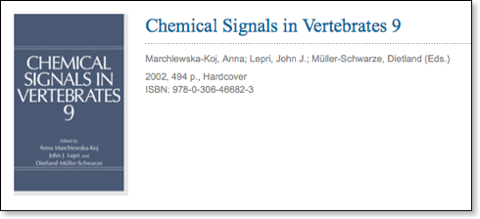Myths about MUPs

Beynon, R.J., Hurst, J.L., Gaskell, S.J., Hubbard, S.J., Humphries, R.E., Malone, N., Marie, A.D., Martinsen, L., Nevison, C.M., Payne, C.E., Robertson, D.H.L. & Veggerby,C. (2001) Mice, MUPs and myths – structure-function relationships of the major urinary proteins. In: Chemical Signals in Vertebrates (Ed. A. Marchlewska-Koj, D. Muller-Schwarze & J. Lepri) pp149-156. New York: Plenum Press.
MUPs are more than simple delivery agents for pheromone molecules. Key to these additional roles is the notable molecular heterogeneity that these proteins evince. Cavity mutants have the potential to modulate the delivery of pheromones in the time domain, manipulating the ratio of molecules released and remaining in the sample. Surface mutants might also alter ligand affinity through manipulation of backbone conformational entropy. More importantly, the discovery of a MUP receptor introduces the possibility of manipulation of surface mediated interactions at the vomeronasal organ, and the key datum delivered by this interaction would be individual identity.
Previous emphasis on urine-mediated individuality signals has focussed on either volatile metabolites released in urine according to haplotype (Singer et al., 1997; Yamazaki et al., 1999) or the secretion of the soluble histocompatibility (MHC) molecules (or fragments thereof) into mouse or rat urine (reviewed in Singh, 1999). In the latter model, the high degree of allelic variation in MHC molecules is a key component of individuality signalling. Further, it has been postulated that the binding groove of the MHC proteins, normally a binding site for an antigenic peptide, might also function as a binding site for a volatile molecule. This has evolved to the notion of the ‘carrier hypothesis’ for communication of individuality. Whilst this may be attractive in principle, we suggest that MUPs are far better candidates for such carriers than MHC molecules. They are highly polymorphic, have evolved to be secreted in urine and posses a large, flexible binding pocket for lipophilic (and thus, volatile) molecules. It has to be acknowledged that in all studies using urine-derived protein fractions, these fractions contain both MHC molecules and MUPs. It has not been possible to assess the role of MUPs in the absence of MHC molecules, or vice versa. Studies with recombinant MUPs should eliminate these problems, provided it can be demonstrated that the proteins are not contaminated with proteins derived from the expression host (usually bacteria or yeast). Alternatively, techniques will need to be developed for selective purification of the two components. Further tests should explore the magnitude of the MHC effect on a variant MUP background, and vice versa.
MHC molecules and MUPs share many properties that make them ideal as mediators of individual identity; they are ‘hard-coded’ into the genome, are expressed in both sexes, exhibit similar degrees of polymorphism and are largely independent of status. The plethora of MUP polymorphic variants hints at a matching family of MUP receptors, and the matching of two polymorphic proteins (MUP and MUP receptor) would have the combinatorial potential to encode individuality data. In such a model, the role of volatile ligands may be subsumed into different functions, such as communication of sex or status or acting as ‘alerter’ molecules.